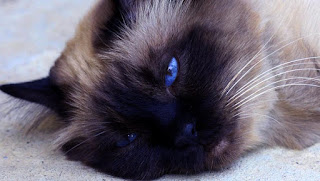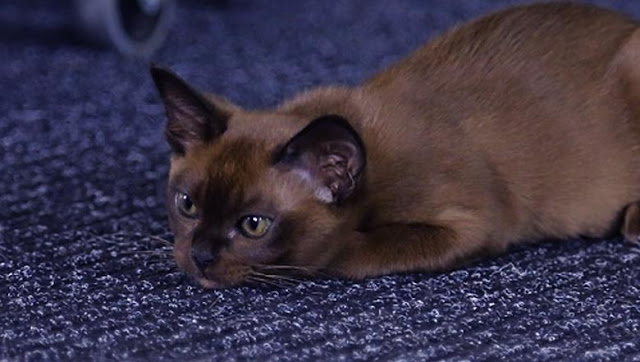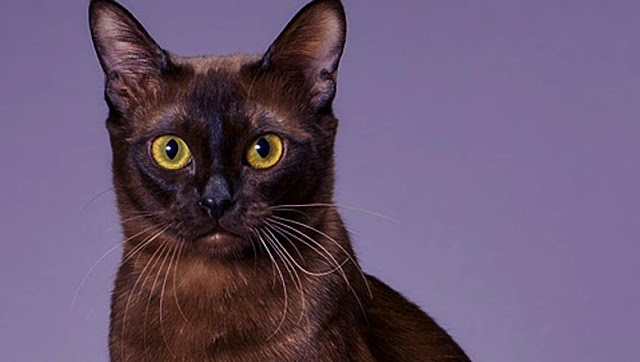The Burmese Cat Originally from Thailand, the Burmese can be described as a lucky cat. The Burmese appreciate the company of man and are tr...
The Burmese Cat Originally from Thailand, the Burmese can be described as a lucky cat. The Burmese appreciate the company of man and are true chatterboxes! They are particularly playful.
Burmese Cat Article Summary :
- Appearance of the Burmese
- Character of the Burmese
- History of Burmese
- Burmese Health
- Breeding of the Burmese
- Care and nutrition of the Burmese
Appearance of the Burmese
The Burmese cat belongs to the oriental breed cats. It is native of Burma, the current Myanmar. In spite of their similar names, it is necessary to make the distinction between the Burmese and the cat of Burma. The Burmese of Europe and the one from the other side of the Atlantic each have their own standard. This is explained by their great physical differences.
The American Burmese is robust, with a large chest, a large head and a short muzzle. The European Burmese from Great Britain is slimmer and athletic in type. It is mainly found in Europe and can be small to medium in size. Females weigh up to 4 kilos and male cats up to 6 kilos. These graceful and strong animals resemble the old type Siamese cats but are not as thin as the current Siamese.
Burmese cats have a broad chest and a straight back, on very thin, oval legs. The wedge-shaped head of the Burmese with rounded forehead is characterized by large, wide open ears and large eyes. These are golden or amber in color, slightly almond-shaped.
The shiny coat of the Burmese is particularly adapted to the climate of the countries of South Asia, because of its lightness. One finds only very little undercoat, which remains close to the body.
The color of must be plain and free of spots. Very young kittens often show a slight Tabby effect on their coat. A slightly dark facial mask is not uncommon and is more than desirable according to the Burmese standard. Ten different colors are recognized in the Burmese: Blue, Chocolate, Seal and Red, their dilutions Lilac, Cream as well as color combinations such as Chocolate-Torte, Blue-Torte, Seal-Torte and Lilac-Torte. Here is a more detailed list of the different types of Burmese coats:
- Seal: The Burmese Seal is dark brown or warm brown. Its muzzle and pads are dark.
- Chocolate: The Chocolate cat differs from the Seal by its paw pads which are cinnamon or chocolate in color.
- Blue: The Blue Burmese are particularly beautiful, with a blue-grey coat with steel reflections.
- Lilac: the dilution of brown gives a dove gray color with a slight pink sheen, visible in the Lilac cat from the muzzle to the paw pads.
- Red: the red cat has a red-orange coat. The muzzle and the paw pads are here pink.
- Cream : The dilution of red gives a light beige color. The muzzle and the paw pads are also pink as for the red cat.
The English term "Torte" refers to tricolor cats, also called "torte shell". Because of the genetic particularity of this color, all tricolor cats are female. This cat breed is also recognized under various Torte colors:
- Seal-Torte: it has a red base coat and dark brown spots. The muzzle and the pads can be pink or brown with pink spots.
- Chocolate-Torte: it has a chocolate base color and beige spots. The muzzle and pads can be chocolate brown or pink, pink spots are also possible.
- Lilac-Torte: the dress of the Burmese lilac-torte has a dove gray base color, apricot and dark beige spots, pink muzzle and paw pads.
Depending on the country, there are other peeling variants. In New Zealand for example, we see Cinnamon, Fawn, Caramel, Apricot and Silver variants. Tabby colors are also partly recognized.
Character of the Burmese
The Burmese cat is intelligent, curious and spirited. These confident cats are very close to humans. They are playful and love children.
Note: Burmese are agile and lively until an advanced age. They demand their master's attention 24 hours a day and love to communicate with their feline counterparts. These cats are not made to live alone!
These animals are constantly on the move and love to be stimulated both physically and mentally. This is why it is not very wise to have them live indoors. If you want to allow this little ball of energy to live in an adapted environment, provide it with a garden equipped with cat accessories or at least a balcony, with a scratching post to do its claws and let off steam, but also other objects allowing it to have fun and observe the surroundings. If he has a cat companion, his pleasure will be multiplied!
History of Burmese
The story of this cat from Burma, now called Myanmar, has not been completely clarified yet. The Burmese lived alongside the monks and were one of the 16 breeds of temple cats. Even today it is known in Asia under its Thai name of "Maeo Thong Daeng".
Rumor has it that Burmese cats were present at the first cat show in England in 1871. They were presented there under the name "Chocolate Siamese", and today's American Burmese bears a strange resemblance to them. However, nothing proves that these cats were really Burmese.
On the other hand, it is certain that in the 1930's, a US Navy doctor took a Burmese cat with him, bound for San Francisco. The animal resembled a light brown Siamese cat. Very quickly, teams of researchers and breeders got together to study the genetic characteristics of this cat, named "Wong Mau". And they came to the conclusion that the cats from ancient Burma were not dark-colored Siamese but a breed in their own right.
The cats "Wong Mau" and "Tai Mau" (a Sealpoint Siamese) were mated. Afterwards, another crossbreeding with a male descendant of "Wong Mau" gave birth to kittens with dark brown coat. The first parents of the modern breeding of the Burmese breed were born!
In 1936, the Burmese was recognized by the Cat Fanciers Association. Due to repeated crossbreeding with the Siamese, the status of the breed in its own right was cancelled a decade later. A few rare breeders devoted themselves exclusively to the pure Burmese breed and thus clearly distinguished themselves from Siamese breeding.
It was in 1954 that the Burmese was again recognized as a breed in its own right. In 1958, the United Burmese Cat Fanciers (UBCF) established its own breed standard, which has remained unchanged since then. The 1950's marked the beginning of Burmese breeding in Great Britain. Finally, in 1952, the breed was recognized by the United Kingdom's Governing Council of the Cat Fancy (GCCF).
The breeding of Burmese in Great Britain was among others based on the old American Burmese, which today differs a lot from the current American type. The difference between each type can be explained by the fact that Burmese cats of the "traditional" British type are not recognized in the United States, Australia or New Zealand. In the same way, kittens resulting from crossbreeding with cats from America are not recognized by the standard.
In 1970, the first litter of Burmese cats was born in Germany and it is at this time that the breed began to gain popularity throughout Europe. Even today, Burmese cats of the traditional and British type can still be found in Europe. In New Zealand, Australia and the United States, the American breed standard continued to be raised.
The Burmese also gave birth to other breeds, such as the Tonkinese and the Burmilla.
Burmese Health
A 2008 study highlights the fact that American Burmese breeders have a lower genetic diversity than other modern breeds. This means that there is a close kinship between Burmese cats. Because of this, in the United States, crossbreeding between cats of the Bombay and Tonkinese breeds is allowed. Breeding cats with a low genetic diversity induces the risk of inbreeding mating and the resulting genetic diseases. However, there is good news for cat lovers! According to statistics, Burmese have the longest life expectancy. On average, they live 17 years!
- However, Burmese's are often affected by the "congenital vestibular syndrome". This hereditary disease affects the inner ear of cats, causing balance disorders and in some cases, deafness in affected cats.
- Diabetes mellitus is also frequently found in British-type Burmese cats. Diabetes in cats is not curable, but with the right treatment, it is no longer fatal.
- Furthermore, these cats are also subject to a deficiency of potassium in the blood, a condition called hypokalemia. This autosomal recessive disease is often transmitted in a hidden way. If both parents have a predisposition to hypokalemia, then the kitten will be affected. The disease can be mild or fatal.
- Another disease affecting Burmese cats is endocardial fibro elastosis. This disease exclusively affecting kittens is characterized by a thickening of the muscular walls of the heart.
Breeding of the Burmese
These diseases can only be prevented by serious and responsible breeding methods of professional breeders. If you wish to adopt a Burmese, find out about professional breeders in your area. Above all, don't buy your cat blindly or in haste, trusting people who present themselves as breeders and offer "purebred cats at a good price". This is not only a matter of the animal's identity papers, but also their breed standard. The most important thing is the breeder's know-how and attitude towards the animals. Breeding cats is still an expensive activity. Before the kittens reach the required age to be adopted, they require a lot of time from their breeder and the expenses necessary for their health and well-being are numerous. These include veterinary expenses for the mother and the kittens such as preventive examinations, care of the mothers during pregnancy, vaccinations, possible castrations and deworming.
Giving importance to a balanced diet also represents a cost, especially when the choice is oriented by the quality of the products. Professional breeding allows kittens to learn everything they need to know alongside their mother and siblings. Once adopted, they have already been socialized. To do so, they must stay 12 weeks in the kennel. During these few weeks, the breeder is at their disposal day and night.
This is not only a question of money, but a real concern for the animals' well-being. So don't be surprised if the breeders examine you under a magnifying glass when you visit them! They want the best for their cats! Even after your purchase, the breeders can advise you so that the adoption of your kitten takes place in the best conditions!
Here are the reasons for the relatively high price of Burmese cats. As an indication, a Burmese kitten costs approximately 700 euros. Some breeders also offer the possibility to acquire adult animals and often at more advantageous prices.
You can also go to an animal shelter. Many animals of all ages are waiting there for a new home!
Care and nutrition of the Burmese cat
Found the cat of your dreams? Congratulations! It's very pleasant to share the daily life of a Burmese cat, knowing that it is very undemanding. However, don't forget that these playful cats need mental and physical stimulation. So that your cat does not start climbing everywhere or scratching where it is forbidden, a balcony or a secure garden would be perfect.
Scratching posts and cat toys play an important role for the Burmese because they allow him to let off steam. The Burmese are sociable animals and very close to humans but still appreciate the presence of other animals. This is especially true if you are away for a large part of the day. Moreover, being an oriental cat, the Burmese has a rather dominant character. It would therefore be easier to make him cohabit with a cat of calm nature. To make things easier, you can without hesitation take a cat from the same litter! They already know each other and have already established certain bonds of trust. This way, they will discover their new home together!
As far as cat food is concerned, the Burmese, like all cat breeds with a relatively high life expectancy, must eat a quality food, rich in meat. Watch the carbohydrate level, which should be low.
To be sure that your Burmese is in good health and to update its vaccinations, do not forget the annual visit to the veterinarian. Take this opportunity to ask all your questions!
We wish you wonderful moments in the company of your lucky cat!





No comments